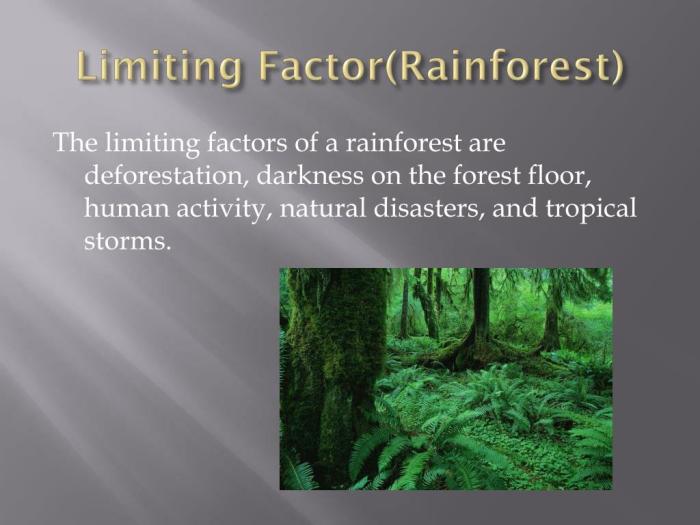Limiting factors of the tropical rainforest – Limiting factors are fundamental elements that influence the distribution, growth, and diversity of organisms within an ecosystem. In the context of tropical rainforests, a myriad of factors interact to shape the intricate tapestry of life, ranging from climatic conditions to human interventions.
This discourse delves into the multifaceted limiting factors that govern the functioning of these verdant realms.
Temperature, precipitation, sunlight, soil fertility, and drainage profoundly impact plant growth and species composition. Altitude, slope, and aspect modulate temperature and moisture patterns, further influencing vegetation distribution. Biotic interactions, such as competition and herbivory, play a crucial role in shaping plant communities.
Human activities, including deforestation and climate change, pose significant challenges to the integrity of tropical rainforests.
Limiting Factors of the Tropical Rainforest
Tropical rainforests are the most diverse ecosystems on Earth, home to an estimated 50% of the world’s plant and animal species. However, these ecosystems are also extremely fragile, and their continued existence is threatened by a number of factors, both natural and human-induced.
Climatic Factors
The climate of a tropical rainforest is characterized by high temperatures, heavy rainfall, and abundant sunlight. These conditions are ideal for plant growth, but they can also be limiting factors.
Temperature plays a major role in plant growth and distribution. The optimal temperature for most rainforest plants is between 25 and 30 degrees Celsius. However, temperatures can often exceed 35 degrees Celsius during the day, and this can stress plants and reduce their growth rate.
Precipitation is another important climatic factor in tropical rainforests. The average annual rainfall in a rainforest is between 2,000 and 4,000 millimeters. This heavy rainfall can leach nutrients from the soil, making it difficult for plants to obtain the nutrients they need to grow.
In addition, heavy rainfall can also lead to flooding, which can damage plants and destroy their root systems.
Sunlight availability is also a limiting factor in tropical rainforests. The dense canopy of trees in a rainforest blocks out most of the sunlight, making it difficult for plants to photosynthesize. As a result, plants that grow in the understory of a rainforest are often smaller and have less leaves than plants that grow in the canopy.
Soil Conditions
The soils of tropical rainforests are typically poor in nutrients. This is because the heavy rainfall in rainforests leaches nutrients from the soil. In addition, the dense vegetation in rainforests prevents organic matter from accumulating in the soil. As a result, the soils of tropical rainforests are often acidic and have low levels of nitrogen and phosphorus.
Soil fertility affects plant growth and species diversity. Plants that are able to tolerate low soil fertility are more likely to survive in a rainforest. As a result, the plant species diversity in a rainforest is often lower than the plant species diversity in other ecosystems.
Soil drainage is also an important factor in rainforest ecosystems. The soils of tropical rainforests are often poorly drained, which can lead to waterlogging. Waterlogging can damage plant roots and make it difficult for plants to obtain the oxygen they need to survive.
Topographic Factors

The topography of a rainforest can also affect the distribution of plants. Altitude, slope, and aspect all play a role in shaping rainforest vegetation.
Altitude affects temperature and precipitation patterns. The temperature of a rainforest decreases with increasing altitude. This is because the air at higher altitudes is less dense and holds less heat. In addition, the precipitation in a rainforest increases with increasing altitude.
This is because the air at higher altitudes is cooler and can hold more moisture.
Slope also affects rainforest vegetation. The steeper the slope, the faster the water will drain away from the soil. This can make it difficult for plants to obtain the water they need to survive. As a result, the vegetation on steep slopes is often less dense than the vegetation on gentle slopes.
Aspect (direction of slope) also affects sunlight exposure and plant growth. The north-facing slopes of a rainforest receive more sunlight than the south-facing slopes. As a result, the vegetation on north-facing slopes is often more dense than the vegetation on south-facing slopes.
Biotic Interactions: Limiting Factors Of The Tropical Rainforest

The interactions between plants and animals in a rainforest can also be limiting factors. Competition, herbivory, and mutualism all play a role in shaping rainforest plant communities.
Competition is a major force in rainforest plant communities. Plants compete for light, water, and nutrients. The plants that are most successful in competition are those that are able to tolerate low light levels, low nutrient levels, and high levels of competition.
Herbivory is another important factor in rainforest plant communities. Herbivores eat plants, and this can damage plant tissues and reduce plant growth. The plants that are most successful in avoiding herbivory are those that have tough leaves, produce toxins, or have other defenses against herbivores.
Mutualism is a type of interaction in which two organisms benefit from each other. Mutualism is common in rainforest plant communities. For example, some plants provide food for ants, and the ants in turn protect the plants from herbivores.
Human Impacts

Human activities are also a major threat to tropical rainforests. Deforestation, climate change, and conservation efforts are all having a significant impact on these ecosystems.
Deforestation is the clearing of forests for other uses, such as agriculture, logging, and mining. Deforestation is a major problem in tropical rainforests, and it is estimated that over 17% of the world’s rainforests have been cleared since 1990.
Climate change is also a major threat to tropical rainforests. Climate change is causing the temperature of the Earth to rise, and this is leading to changes in precipitation patterns and sea levels. These changes are having a negative impact on rainforest ecosystems, and they are expected to become even more severe in the future.
Conservation efforts are essential to protect tropical rainforests. Conservation efforts can include the establishment of protected areas, the promotion of sustainable land use practices, and the education of local communities about the importance of rainforests.
Q&A
What are the primary climatic factors that influence tropical rainforests?
Temperature, precipitation, and sunlight availability are the key climatic factors that shape the distribution and growth of plants in tropical rainforests.
How does soil fertility affect rainforest ecosystems?
Soil fertility plays a crucial role in determining plant growth and species diversity. Nutrient-rich soils support a wider range of plant species, while nutrient-poor soils limit plant growth and diversity.
What is the impact of human activities on tropical rainforests?
Human activities, such as deforestation and climate change, pose significant threats to tropical rainforests. Deforestation reduces habitat availability and disrupts ecosystem processes, while climate change alters temperature and precipitation patterns, affecting plant growth and species composition.